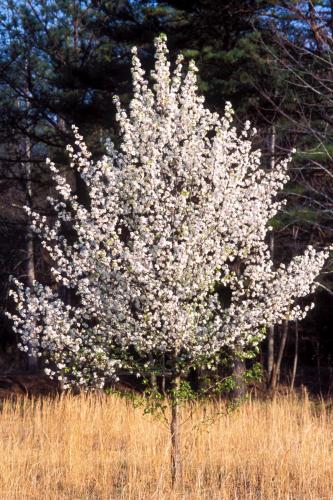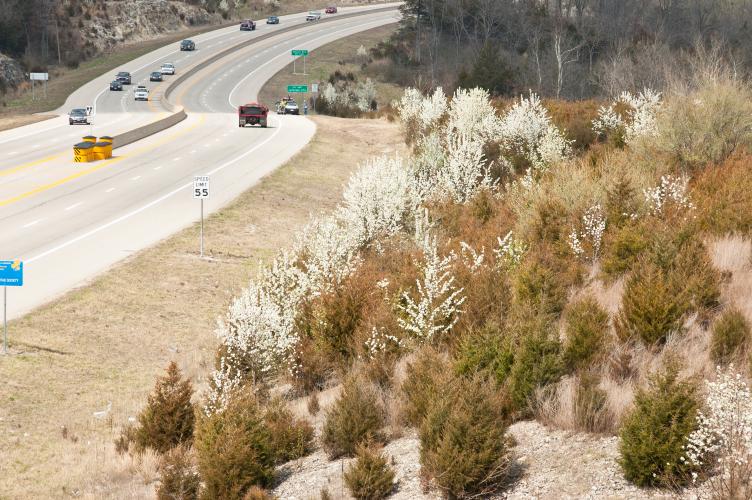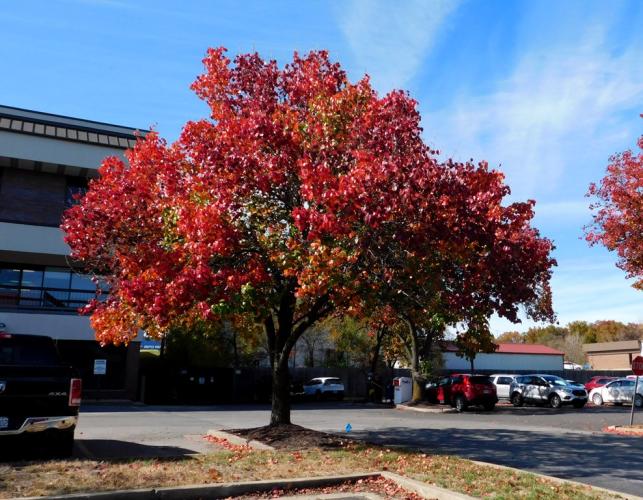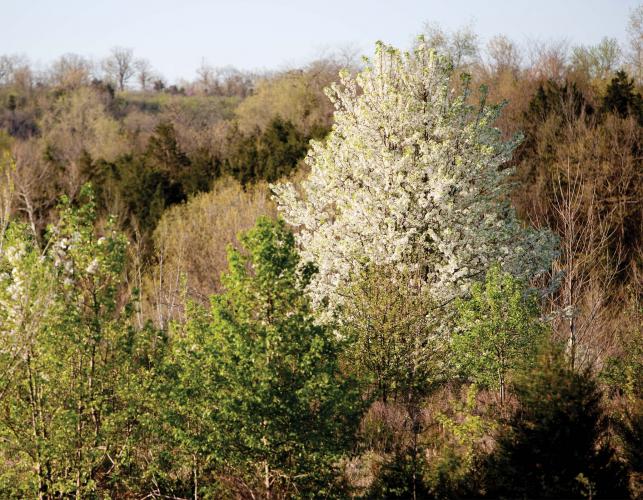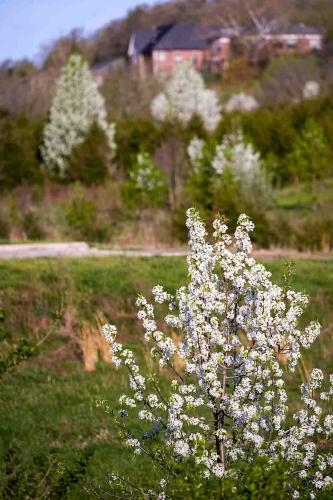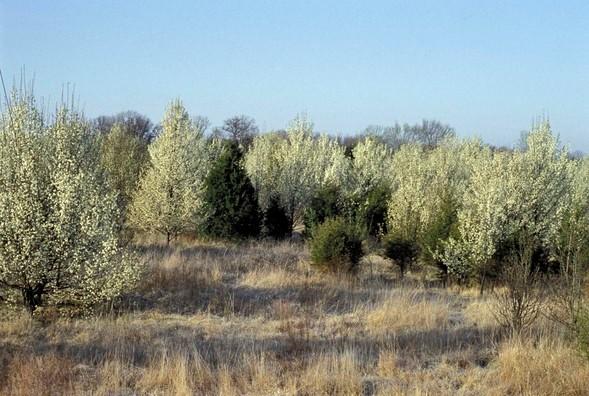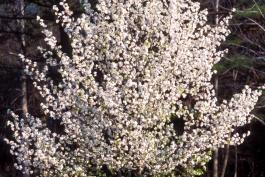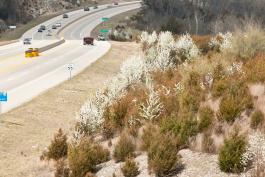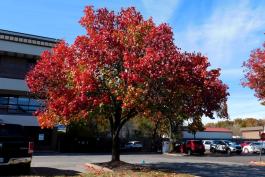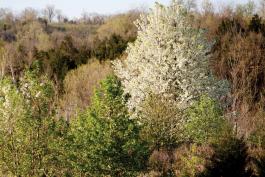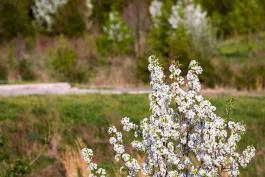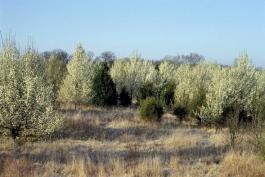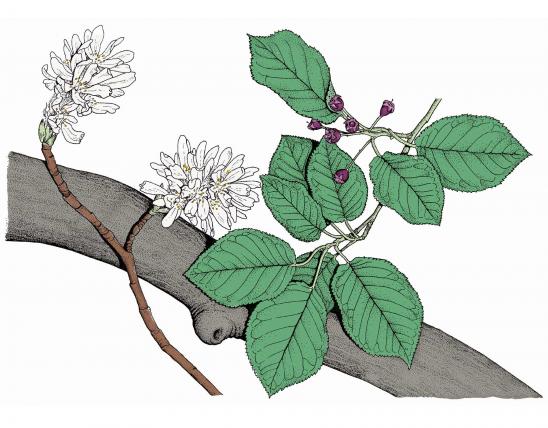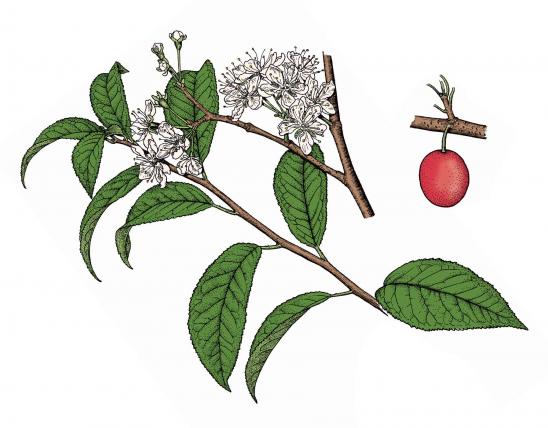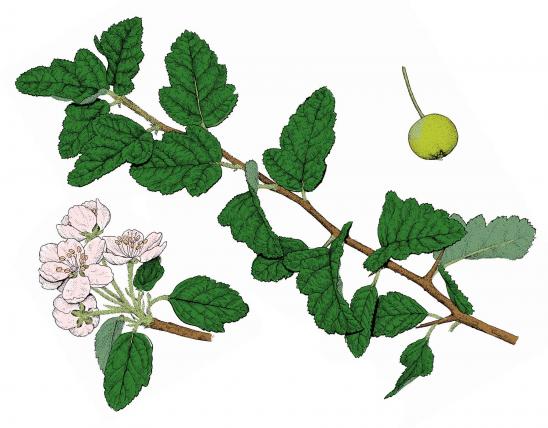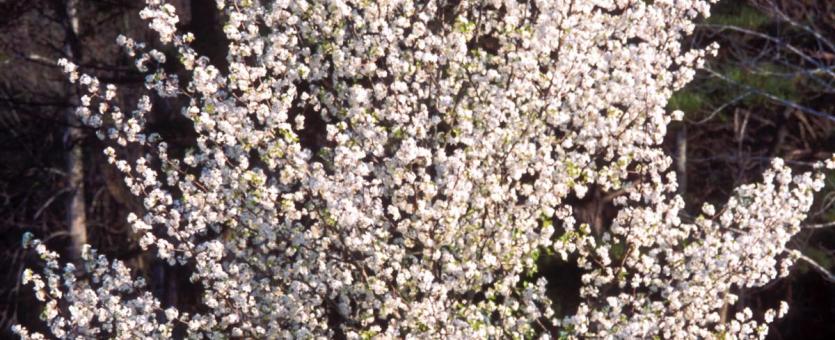
Callery pear is a small to medium-sized tree with a compact, symmetrical, pyramidal, or columnar shape that spreads to become oval with age. Many cultivars exist with slightly different characteristics; all contribute to the species' invasiveness.
Leaves are alternate, simple, generally oval, to 3 inches long, with rounded teeth, glossy green, turning orange, gold, red, pink, and/or purple in fall. Some cultivars develop patterns of colored circles and spots in autumn. Leaves bob in the wind on long leaf stems.
Bark is gray brown, smooth on young trees, splitting into scales with age.
Twigs are thornless in cultivated trees, but in wild types (including trees that develop from sprouts of a tree that was felled), the twigs end in thorns.
Flowers in early spring; abundant clusters of white flowers, 5-petaled, each to ¾ inch wide, unpleasant-smelling.
Fruits are like tiny, hard apples, round, to ½ inch in diameter, greenish yellow flecked with whitish spots, inedible (for humans), with 2–4 black seeds. After freezes they soften, darken, wrinkle, and become palatable to birds.
Key identifiers:
- Deciduous tree, dropping its leaves in fall, reaching up to 30 to 50 feet tall.
- Overall tree shape pyramidal, columnar, or egg-shaped.
- Wide-spreading branches fairly vertical, branching symmetrically.
- Branches sometimes thorny.
- Leaves shiny, dark green, leathery, with small-toothed margins.
- Leaves turn reddish purple or orangish red in the fall.
- Flowers in spring before leaf-out.
- Flower petals white, rounded, close together (they touch/overlap at their bases).
- Flower stamens are not longer than the petals.
- Fruits in fall are small, round, hard, and brown.
Similar species: Several other trees bloom in spring with white, five-petaled flowers. Serviceberry has petals that are brighter white, strap-shaped, wavy, with a space between them (not rounded and close together). Native plums have stamens (threadlike stalks in the center of the flower) that are longer than the petals. Apple and crabapple flowers have a slightly pink hue, and apple tree branches are nearer to horizontal and less uniform, compared to the vertical, symmetrical branching of Callery pear.
Height: 30–50 feet ('Bradford' variety).
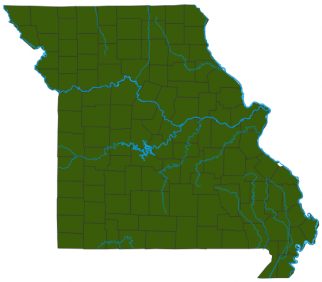
Statewide.
Habitat and Conservation
Callery pear, in its many forms, has been planted in urban, suburban, and rural yards, office and apartment complexes, malls, streets, and college campuses. It grows quickly but dies young, frequently breaking in strong winds. Its vigor and adaptability have contributed to its invasiveness.
As an invasive small tree or shrub, Callery pear forms large colonies. It is conspicuous on roadsides, old fields, and other open, disturbed areas, but it also invades and degrades a variety of natural habitats. The large thickets are most noticeable in spring, when the species is blooming, and in fall, when its leaves turn deep red.
Sometimes a certain variety or cultivar of a tree becomes so popular that the whole species becomes known by that name. 'Bradford' pear is a cultivated variety of Callery pear, and it has been hugely popular in landscaping. Its adaptability to a wide variety of growing conditions, including in the compacted soils along city streets, contributed to its popularity.
Status
Invasive shrub or small tree. Formerly very popular in landscaping.
Native to China and Taiwan, Callery pear has been a hot landscaping plant for decades. The 'Bradford' cultivar is created when a scion (cutting) of a 'Bradford' tree is grafted onto the rootstock of a wild-type Callery pear. The cultivated forms were thought to be sterile, but recently they’ve been spreading — alarmingly. This happens when many different self-sterile forms are planted close by (as in towns) and can cross-pollinate and produce fertile fruits.
Birds and other animals eat the fertile fruits and distribute the seeds widely. A single tree can spread quickly, forming dense thickets. The thickets leaf out early, outcompeting native flowers and trees. Once escaped from cultivation, wild trees develop long thorns, making thickets impenetrable.
Also, when it gets large, Callery pear develops "weak crotches" where the limbs join the trunk, and the tree is easily split or knocked over by wind. After the fallen tree is removed, vigorous sprouts appear at the stump. These sprouts will grow into the wild, less-attractive, thorny, invasive form of the tree, whose fertile fruits are spread by birds and other animals.
Human Connections
Callery pear and other invasive plants destroy habitat and compete with native plants and animals. Please do not plant these invaders. We recommend replacing your Callery/Bradford pears with a variety of other small native trees, such as serviceberry, yellowwood, redbud, and hornbeam.
Callery pear became popular in landscaping for several reasons, such as its quick growth, tolerance for a variety of soil types, even shape, pretty fall color, and (it was believed) inability to reproduce by seed. But many of its forms had serious downsides. The 'Bradford' cultivar, for example, tends to produce heavy limbs with narrow branch unions that may fail and split under an ice or wind load.
In spring, Callery pears are covered with white blossoms. Many people find the scent of blooming Callery pears revolting, likening it to the stench of rotting fish or a dirty dumpster.
The various names reflect the history of this tree as it connects to scientists and horticulturalists:
- The name Callery honors the nineteenth-century French priest and Sinologist (scholar of China) Joseph-Marie Callery, who sent samples of this plant to botanists in Europe. Callery pear was imported to America by Frank Meyer, a USDA scientist working in China and tasked with locating disease-resistant fruit trees for US agriculture. (The sweet-tasting Meyer lemon was named for him.)
- The cultivar 'Bradford' was named for Frederick Charles Bradford, one of the chiefs at a USDA plant station in Maryland in the early 1950s. He noticed the tree's ornamental qualities and began work to develop the cultivar that would be named for him. 'Bradford' pear was released to the public in 1963, 12 years after Bradford's death.
Ecosystem Connections
Callery pears are invasive. They can crowd and shade out our native plants, reducing the diversity of plants and, thus, of animals too. The wild forms often develop characteristics of the original Chinese trees, including stout thorns that make them difficult to clear. The thorns also discourage deer from browsing on them.
Apparently, few North American insects chew the leaves of Callery pear. While this is traditionally considered a "plus" for landscape plants, ecologists point out that plants that are not eaten by insects have little role in a healthy natural ecosystem. Plant-eating insects, for example, feed birds.
The fruits of Callery pear, though unpalatable to people, are readily eaten by songbirds such as American robin, northern cardinal, northern mockingbird, gray catbird, and European starling. The birds digest the fruits and poop out the seeds in new locations, spreading the species into natural habitats.
Callery pear's flowers are specialized for attracting flies, including blow flies, which serve as pollinators. This explains their fetid, dead-animal odor.
